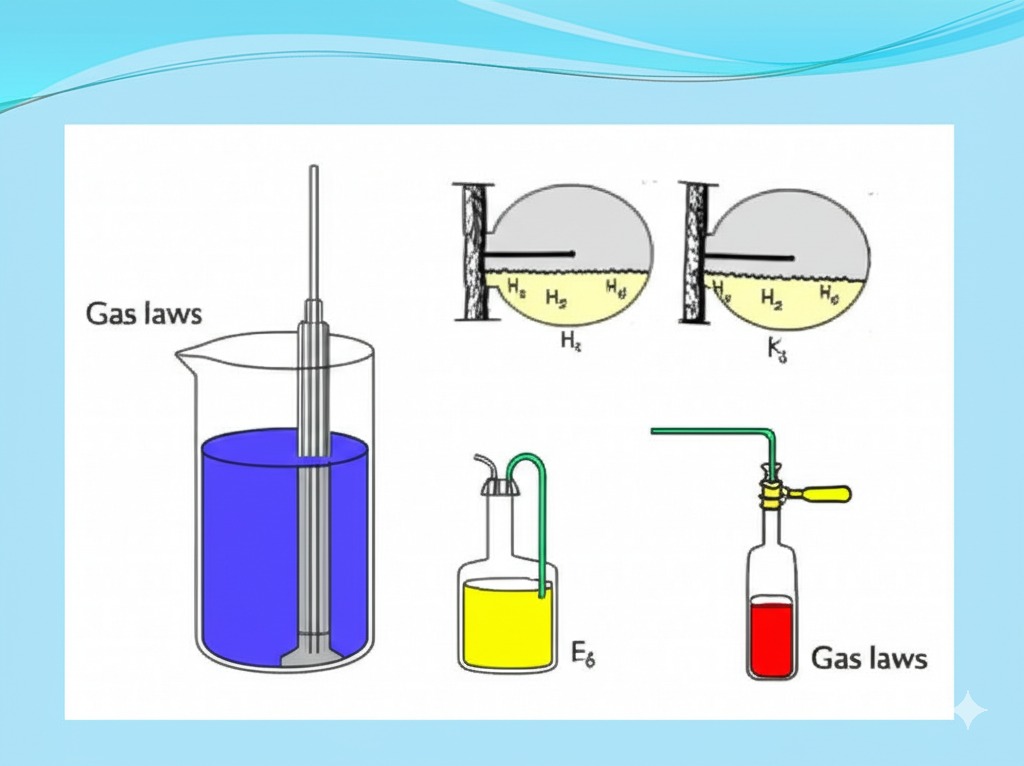Answer Key
ICSE Chemistry Term 2 (2025) Sample Paper
Chapter: Gas Laws
Section A: Multiple Choice Questions
1. The graph of PV vs P for a gas is:
Answer: (c) A straight line parallel to the X-axis
2. The absolute temperature corresponding to 27°C is:
Answer: (b) 300 K
3. The volume-temperature relationship of gases is given by:
Answer: (d) Charles’s law
4. If pressure is doubled for a fixed mass of gas, its volume will:
Answer: (b) Decrease to ½
5. The SI unit of temperature is:
Answer: (b) Kelvin
6. The temperature known as the steam point is:
Answer: (b) 373 K
7. Boyle’s law states that:
Answer: (a) The volume of a gas is inversely proportional to its pressure
8. The standard temperature and pressure (STP) are:
Answer: (a) 273 K and 760 mm Hg
9. The boiling point of water on the Kelvin scale is:
Answer: (c) 373 K
10. The relationship between the Celsius and Kelvin scales of temperature is:
Answer: (a) ( K = °C + 273 )
Section B: Very Short Answer Questions
11. Match the following:
| Column A | Column B |
|---|---|
| (a) Cm³ | (i) Volume |
| (b) Kelvin | (ii) Temperature |
| (c) Torr | (iii) Pressure |
| (d) Boyle’s Law | (iv) ( PV = P_1V_1 ) |
| (e) Charles’s Law | (v) ( frac{V}{T} = frac{V_1}{T_1} ) |
Answer: (a) – (i), (b) – (ii), (c) – (iii), (d) – (iv), (e) – (v)
12. Fill in the blanks:
- The average kinetic energy of gas molecules is proportional to the absolute temperature.
- The temperature on the Kelvin scale where molecular motion ceases is called absolute zero.
- If temperature is reduced by half, the volume will also reduce by half.
- The melting point of ice is 273 K.
Section C: Short Answer Questions
13. What do you understand by gas?
Answer: A gas is a state of matter in which the particles are far apart and move freely. Gases have no fixed shape or volume and expand to fill the container.
14. Explain diffusion with an example.
Answer: Diffusion is the process by which gas molecules spread from an area of higher concentration to an area of lower concentration. For example, when perfume is sprayed in one corner of a room, its scent gradually spreads throughout the room.
15. How is molecular motion related to temperature?
Answer: As the temperature increases, the kinetic energy of the gas molecules increases, causing them to move faster. Conversely, a decrease in temperature results in slower molecular motion.
16. Define absolute zero and absolute scale of temperature.
Answer: Absolute zero is the theoretical temperature at which all molecular motion ceases (0 K or -273.15°C). The absolute scale of temperature, measured in Kelvin, starts at absolute zero and provides a true, non-negative measure of thermal energy.
17. State STP conditions.
Answer: STP (Standard Temperature and Pressure) is defined as 0°C (273 K) and 1 atmosphere (760 mm Hg).
18. What is the need for the Kelvin scale of temperature?
Answer: The Kelvin scale provides an absolute reference beginning at absolute zero, making it essential for accurate thermodynamic and kinetic calculations.
19. Give two assumptions of the kinetic molecular theory.
Answer:
- Gas molecules are in constant, random motion.
- Collisions between gas molecules are perfectly elastic.
20. Why is it necessary to compare gases at STP?
Answer: Comparing gases at STP ensures that the measurements are made under the same standard conditions of temperature and pressure, eliminating discrepancies due to environmental variations.
Section D: Conceptual and Explanation-Based Questions
21. State Boyle’s law with its significance.
Answer: Boyle’s law states that for a fixed amount of gas at constant temperature, the pressure is inversely proportional to the volume (( PV = text{constant} )). This law is significant because it explains how gases behave under compression and expansion.
22. State Charles’s law with its significance.
Answer: Charles’s law states that at constant pressure, the volume of a gas is directly proportional to its absolute temperature (( frac{V}{T} = text{constant} )). This relationship explains why gases expand when heated and contract when cooled.
23. The molecular theory states that gas pressure is caused by molecules striking the vessel walls. How will pressure change if:
- The temperature is doubled while keeping volume constant:
Answer: The pressure will double, as increased temperature raises the kinetic energy and collision rate of the molecules. - The volume is reduced to half while keeping temperature constant:
Answer: The pressure will double, following Boyle’s law, because the molecules collide more frequently with the container walls.
24. Give reasons for the following:
- All temperatures on the absolute scale are positive:
Answer: Since the Kelvin scale starts at absolute zero (the point where molecular motion ceases), all measured temperatures are positive. - Gases have lower density than solids or liquids:
Answer: Gas particles are much farther apart than those in solids or liquids, resulting in a lower mass per unit volume.
25. Why do mountaineers carry oxygen cylinders with them?
Answer: At high altitudes, the atmospheric pressure is lower, leading to reduced oxygen concentration. Oxygen cylinders supply supplemental oxygen to prevent hypoxia.
26. What is aqueous tension?
Answer: Aqueous tension is the vapor pressure exerted by water in a mixture of gases, particularly when gas is collected over water.
27. Why does an inflated balloon appear to violate Boyle’s Law?
Answer: An inflated balloon may seem to violate Boyle’s Law because the elastic forces of the balloon’s rubber add an extra variable, altering the simple inverse relationship between pressure and volume.
Section E: Descriptive Questions
28. Explain Boyle’s Law based on the kinetic theory of matter.
Answer: Boyle’s Law is explained by the kinetic theory by noting that gas molecules are in constant, random motion. When the volume of a container decreases, molecules collide more frequently with the walls, thereby increasing the pressure. This inverse relationship is expressed as ( PV = text{constant} ).
29. Explain Charles’s Law based on the kinetic theory of matter.
Answer: According to the kinetic theory, when the temperature of a gas increases, the molecules gain kinetic energy and move more rapidly, causing the gas to expand. This direct proportionality between volume and temperature at constant pressure is given by ( frac{V}{T} = text{constant} ).
30. How does Charles’s Law lead to the concept of absolute temperature?
Answer: Charles’s Law implies that as temperature decreases, volume decreases proportionally. Extrapolating this linear relationship to the point where volume would be zero defines absolute zero (0 K), which forms the basis of the Kelvin scale.
31. Explain the conditions necessary for an ideal gas.
Answer: An ideal gas is described by the following conditions:
- The volume of the gas molecules is negligible compared to the container.
- There are no intermolecular forces between the gas molecules.
- Collisions between molecules are perfectly elastic.
- The molecules move in random, straight-line paths.
These assumptions allow the ideal gas law ( PV = nRT ) to effectively model gas behavior.
32. How does a gas exert pressure?
Answer: Gas pressure results from the continuous collisions of gas molecules with the walls of their container. Each collision exerts a force, and the total force per unit area is observed as pressure.
33. Explain why gases completely fill the container in which they are kept.
Answer: Gases completely fill their container because the molecules are in constant, random motion and spread out uniformly, occupying all available space due to the absence of strong intermolecular attractions.
Section F: Application/Graph-Based Questions
34. A gas is kept in a cylinder with a movable piston. The mass and temperature of the gas remain constant. How does reducing the volume affect pressure? Justify with Boyle’s Law.
Answer: Boyle’s Law states that ( PV = text{constant} ). Therefore, reducing the volume increases the frequency of molecular collisions with the piston, resulting in a proportional increase in pressure.
35. A graph is plotted between volume (V) and absolute temperature (T) for a gas sample at constant pressure. Answer the following:
- What will be the shape of the graph?
Answer: A straight line. - Does the graph pass through the origin?
Answer: No, it does not pass through the origin. - Which law does this graph follow?
Answer: Charles’s Law. - Derive its mathematical expression:
Answer: Since ( V propto T ) at constant pressure, we write ( V = kT ) or equivalently, ( frac{V_1}{T_1} = frac{V_2}{T_2} ), where ( k ) is a constant.
36. The table below shows the relationship between temperature and volume for a gas:
| Temperature (°C) | Volume (liters) |
|---|---|
| 27 | 4.8 |
| 77 | 5.6 |
| 127 | 6.4 |
| 177 | 7.2 |
| 227 | 8.0 |
- Identify the trend between volume and temperature:
Answer: Volume increases as temperature increases. - Convert the temperature values to Kelvin:
Answer: (27°C = 300K), (77°C = 350K), (127°C = 400K), (177°C = 450K), (227°C = 500K). - Plot the graph between V and T:
Answer: The graph will be a straight line, showing a direct proportionality between volume and absolute temperature. - Which gas law does this relationship follow?
Answer: Charles’s Law.



